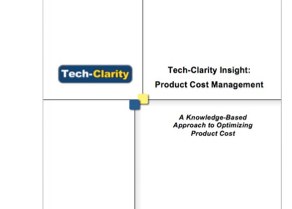 Product Cost Management – A Knowledge Based Approach to Optimizing Product Cost explains how manufacturers can design products for optimal cost in order to improve profitability. The research shares interviews with three industrial manufacturers on the way they work with their supply chains to reduce cost using an analytical, fact-based methodology to drive out unnecessary cost and negotiate fair pricing. The interviews also point out the value of enterprise-class software to enable PCM.
Product Cost Management – A Knowledge Based Approach to Optimizing Product Cost explains how manufacturers can design products for optimal cost in order to improve profitability. The research shares interviews with three industrial manufacturers on the way they work with their supply chains to reduce cost using an analytical, fact-based methodology to drive out unnecessary cost and negotiate fair pricing. The interviews also point out the value of enterprise-class software to enable PCM.
Please enjoy the summary below, or click the report or title to download the full PDF (free of charge, no registration required).
For more information on PCM from our sponsor please visit Siemens PLM’s Teamcenter Product Cost Management page.
Please also see the related Tech-Clarity TV Episode – Optimizing Product Cost with PCM
Executive Overview
Many things factor into the profitability of a product. Innovation, satisfying customer wishes, and product performance drive sales, command price premiums, and boost top-line results. These get a lot of attention and engineers focus passionately on the form, fit, and function of their designs. But engineers don’t have the ability to evaluate the product cost impacts of their decisions to drive profitability from the expense perspective.
Too few companies include a thorough “design for cost” analysis in their product development process to optimize profits. Engineers must optimize cost and make design tradeoffs early in the lifecycle when there is still design flexibility. “You need to have the right concept early on,” advises the Manager of Cost Engineering for a major automotive OEM. “The leverage you have is much higher when you start.” It’s critical to get the cost right as early as possible, particularly for high-volume parts.
Most engineers don’t have visibility to the impact their decisions have on cost. They can’t optimize cost with other design parameters because they don’t have the right information. Product Cost Management (PCM) processes and software enable manufactures to design for cost by providing early visibility to the cost implications of design decisions. PCM allows companies to simulate and evaluate different manufacturing scenarios to develop an ideal “should cost” model based on detailed knowledge of materials, manufacturing processes, and supply chain costs.
PCM benefits go beyond design. Most sourcing efforts result in suboptimal pricing because they aren’t based on how much a part should cost. Predicting manufacturing and supply costs confidently helps companies negotiate better prices based on facts and enables transparent, open discussion with suppliers. “We tell suppliers we aren’t looking for a cost reduction,” explains the Manager of Design Costing and Analysis for an agricultural machinery producer. “We want to improve their process and decrease their work so they can reduce the cost. It’s critical to start the discussion this way.” Beyond savings from one-time negotiations, PCM helps educate suppliers on how to get closer to an ideal should cost model. This win-win approach sets up continuous improvement with vendors to improve prices without putting unrealistic pressure on suppliers to blindly reduce cost. In the end, PCM changes negotiations to a battle of knowledge versus a battle of will and drives more sustainable cost reduction over time.

